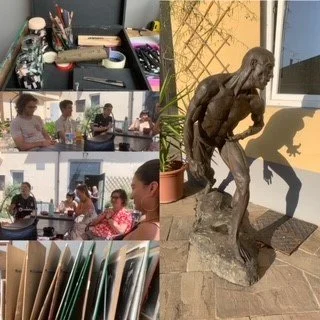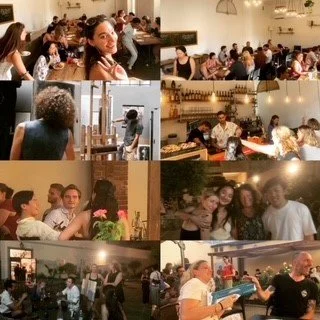Artistic Adventures in Firenze !
Firenze (Florence) Enchants. First established as a Roman colony in 59 BCE, the city later became known as the birthplace of the Renaissance and as a major artistic, cultural, commercial, political, economic, and financial center. Despite its grand legacy, the city feels livable on a human scale with its low- lying sandstone buildings and terracotta rooftops. Six hundred years after it was built, Brunelleschi’s iconic dome remains the tallest building in the city.
In July 2023, I fulfilled a lifelong dream of living and studying art abroad when I flew to Italy to become a student at the Florence Academy of Art (FAA) for one month.
My home during this time was a wee one-bedroom apartment in a former convent (!) on Via Giotto, located near the Porta alla Croce, one of the former gates to what once was the walled city of Florence. Bustling with locals, my little neighbourhood had everything one could want: a coin operated laundry mat (that did double duty as a sauna given the heatwave!); bookstores; a well-stocked Co-Op grocery store selling not only produce, but wine and baked goods (and eggs ‘hidden’ on the shelves!); cafes for both the morning ‘expresso down and dash’ as well as the after work aperitivo ‘sip and savour’; a variety of restaurants; a bike repair shop; a dog grooming parlour (all important for the Dachshunds which may in fact outnumber people in Florence!); and, the infamous geleterias which became beacons of hope during a significant heatwave!
Florence is a walkable city just a little tricky to navigate (especially for those favouring heels!), as many of the streets and sidewalks are made up of uneven cobblestones or large, black basalt stone slabs. It would only take me half and hour to walk along the Arno River either west to the Uffizi Gallery, near Ponte Vecchio, or east to find myself at the entrance to the Florence Academy of Art (FAA).
Elegant metal gates with the FAA logo announced my arrival at the Academy. They open to a large courtyard with buildings painted a beautiful sunny yellow. Passing a striking sculpture of a man in motion, I eventually found myself facing my own reflection in the glass of the front doors. Located in a former customs house, the FAA is comprised of 35,000 square feet of offices, a library, studios, courtyards, exhibition space, and the treasured FAA Café. An American school started by Daniel Graves and several students in 1991, the FAA is ‘a campus for realism’ in which students ‘seek the language of Rembrandt, Velasquez, Titian and Sargent, and the tools to convey their ideas with confidence.’
Scenes from the Florence Academy of Art
My experience at the FAA was enriching. I gained an understanding of the academic method and learned how to see more effectively. Simone Olivia Moritz, born 1985 in Prien am Chiemsee, Germany, is the principal instructor of the course I took entitled, ‘Figure Drawing, the Academic Method.’. Her mastery of drawing and painting is extraordinary, and she is sought after by prestigious students and galleries throughout the world. FAA student Lisa Langer, a talented artist from Stuttgart, Germany, worked as her assistant and I found her no less confident or capable. Under their joint guidance, our small class learned how to apply the sight-sizing method to our drawing practice. Essentially, it requires you to find a vantage point in which the model and the drawing on the easel appear side by side and the same size.
Painting by Simone Olivia Moritz; Instructor’s Exhibit at the FAA.
We began our artistic journey by copying a Charles Bargue drawing, in my case of a young boy. This allowed us to get used to our new environment and warm up over the course of a few days. It also gave us time to get used to our ‘tools’ such as the plumb line, measuring sticks, and charcoal (we used Nitram). Sharpening the latter to a fine point became an art as well as a point of great frustration. There were many times one of us would cry out in despair when we accidently dropped and snapped our charcoal sticks or even dropped them deep into the blackened caverns of the waste bins.
I humbly present my own figure drawings!
When Roberta, our first model joined us, we were able to begin applying the sight sizing method. She was a university student from Rome, who had an admirable capacity to sit still for long periods of time! Over the remainder of our studies, we worked with two other models for approximately one week each. The first, a woman, we captured with charcoal on off-white paper. The second, a man, we captured with charcoal on toned, grey paper, and added highlights with white charcoal and pastel (very minimally). Our other tools included mirrors, one regular one and one black one. They enabled us to confirm the accuracy of our drawings (i.e., proportions, placement) as well as, in the latter case, the accuracy of our tonal gradations. Along the way we also learned how to develop our own value scales to aid in determining tonal variations in our shading.
In terms of materials, the Academy graciously arranged for us to pre-order our supplies for delivery from Zecchi Colori Belle Arti located under the Duomo’s shadow. Stepping into Zecchi is like stepping back in time and, in fact, its building is described on its website as ‘…the ancient " Studio Fiorentino ", the first university of Florence, founded in 1348.’ A rainbow of colourful pigments grace one of the store’s walls and we found it best, on our multiple visits, to ask one of the store owners to help us navigate the precarious stacks of supplies least they topple!
Florence Academy of Art Friends!
In the Figure Drawing class itself, there were fewer than 15 students from all over the world including many regions of the US, Canada, Australia, Bulgaria, England, and France. They ranged in age from high school students to retirees with a wide range of artistic backgrounds. Thank you to Elena, Jess, Isaac, Ashe, Kathryn, Phil, Diane, Lee, Amela (spelling?), David, Iona, and Daphne. I really appreciated your encouragement, guidance, serious talks, and many good laughs.
During this time, there were 150 people taking a range of classes at the FAA including sculpture, écorché, or one of the many painting classes (i.e., figure, still and portrait). Then, there was a cohort of students who were part of the first Masters of Arts in Studio Arts. As a result, our discussions were lively, diverse, and engaging when we spent time during breaks or after classes in the exceptional FAA Café courtyard; especially, on Friday evenings when the café held its happy hour with five-euro drinks and accompanying snacks!
The FAA provided a range of opportunities to allow us to meet fellow students and faculty. They held a Welcome Party in the beautiful gardens of the Budini Gattai Palace; hosted, an amazing concert by the Kanus Quartet, a string ensemble from Mexico, in collaboration with the Virtuoso Belcanto Music Festival; invited us to attend the inspiring instructor’s exhibit; and ensured there was an end of year party in the FAA Café!
Sculptures in the Bargello Museum
The FAA also provided everyone an opportunity to participate in a guided museum visit to the Bargello Museum with the Academy’s resident Art Historian to view major works by Renaissance artists and sculptors. Three of us spent almost an entire day in this museum; Florence’s oldest public building and home to the sculptures of Donatello, Michelangelo, Bernini, Robbia and Verrocchio to name a few.
When not at the Academy, I took the time to explore what felt like a living history book. Every few days, I would take time in my day to visit sights in the city. The beauty of living there is I could head out early and take time to find the sights less overrun by tourists. So, while I did see David in all his glory and the famous artworks by Michelangelo, Leonardo, Botticelli, and others within the Uffizi gallery, I also took the time to marvel at the serenely beautiful paintings by Fra’ Angelico in San Marco one morning. Later on, I stumbled upon the Innocenti Museum which left an indelible impression on me in terms of the histories and tokens of the foundling children parents left there centuries ago. It also provided a unique viewpoint from which to view the Duomo.
Museo del Innocenti Florence
To break up my walk back to the Academy, I would stop for either a cool lavender latte at the Rivarno café , a latte at Café Piansa, or lunch at the Metalucia café which is one of the best brunch spots in Florence. Evening walks home from the Academy required a gelato stop and, after a dinner at home, I often enjoyed sitting with a book by the Arno river with a spritz from either Il Tempio or Habana 500; the latter often had people learning to dance salsa!
On two of the weekends, I did take a few days to travel by train or tour bus in Tuscany. In Cinque Terre, guided by Walkabout Tours, undertook a hike between two of the villages in 36-degree Celsius weather and was relieved to find water to swim in and gelato to eat! In Lucca, I walked the wide city walls and climbed the Torre Guinigio – a tall tower with Holm oaks at its top- to see the city spread out below. I ended that day with a train ride to Pisa for a quick stop at the tower and to confirm it is still leaning!
Back in Florence, I took delight in a spontaneous visit to Il Bisonte Printmaking, an Art Foundation, and International Printmaking School in Florence. Simone Guaita was gracious enough to provide me with a tour and to speak to me about the school’s rich history, range of techniques, and range of programs. Perhaps this is in my future?!
Finally, I was blessed with the visit of friend from England, Colleen, who managed in three days to tour most of the city, visit the FAA, share time with me, and meet my treasured new friends.
Florence’s people, ambiance, history, artworks all enchant. I do hope I may have given you some insight into my experiences at the Florence Academy of Art and around the city. A full picture diary of my time there and in Rome may be found @siobhan_new_adventures.






